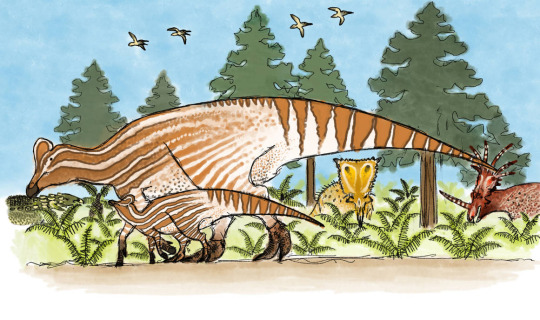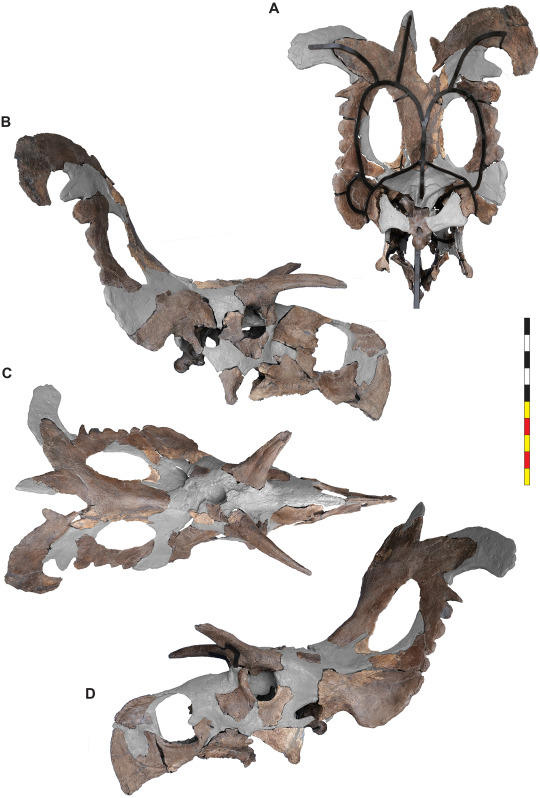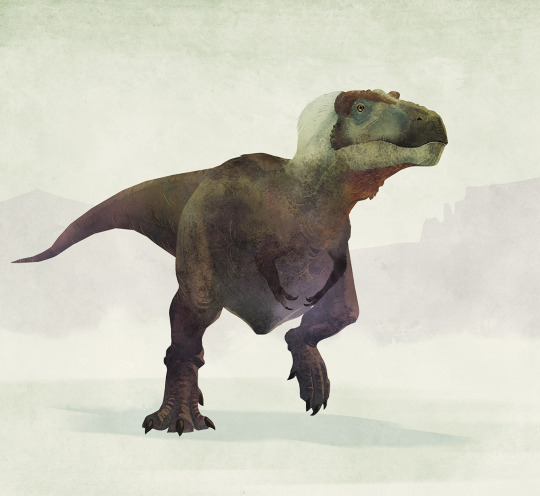#late cretaceous
Explore tagged Tumblr posts
Text
A very curious Pyroraptor spots something interesting (a cycad seed) on the forest floor, and is just...tickled pink by it for some reason.
9K notes
·
View notes
Text

It’s Fossil Friday! Let’s swim back in time about 85 million years to the Late Cretaceous to meet Xiphactinus, a gigantic predatory fish. This species could reach lengths of 17 ft (5.2 m) and was capable of swallowing a 6-ft- (2-m-) long fish whole! The Museum’s Xiphactinus fossils come from Logan County, Kansas, which is home to 70-ft- (21.3-m-) tall sedimentary formations. Though that might not sound like an ideal home for an ocean-dweller, the entire area was covered by a vast inland sea during the Cretaceous. See Xiphactinus in the Museum’s Hall of Vertebrate Origins!
Photo: Image no. ptc-6634 © AMNH (taken 1996)
#science#amnh#museum#fossil#nature#natural history#animals#fact of the day#did you know#fish#paleontology#late cretaceous#cretaceous#sea creatures#marine biology#marine animals#natural history museum#american museum of natural history
1K notes
·
View notes
Text
Mokosh posting!
(She was countlessly slaughtered for no reason)
Alderon ID: @EcdysisArtisan 743-456-796


#illustration#artist on tumblr#paleontology#digital art#ibispaint art#paleontology illustration#spinosaurus#spino#spinosaur illustration#spinosaur#spinosauridae#late cretaceous#paleobr#paleo art#paleo media#PoT#path of titans#path of titans mobile#PoT mobile#Utopian Farmer's Materia Medica
464 notes
·
View notes
Text

Mother and Son’s Day Out, Dinosaur Park Edition
#hypacrosaurus#hadrosaur#hadrosaurs#late cretaceous#campanian#ceratopsians#ceratopsian#chasmosaurus#styracosaurus#edmontonia#dinosaur park formation#cretaceous#paleoart#dinosaur#dinosaurs#paleontology#palaeontology#paleontology art#ornithischian#ornithopod#ornithischians#ornithischia#paleobiology#paleoblr#palaeoblr
428 notes
·
View notes
Text

Aerotitan sudamericanus, an Azhdarchid from the Late Cretaceous with a wingspan of around 5 metres. It was maneuverable both in air and on land, stalking and snapping fish, frogs, lizards, birds and small mammals with it's beak. They are the only known Azhdarchid from South America so far.
Someone had a nice snack! First time trying to draw realistic blood in digital..Not very happy with it but I hope I get better. Currently I'm experimenting with art styles and trying to find what fits me more. I'll be glad to recieve any critique or advices! The colours were based on Swan geese.
#digital art#original art#paleoart#paleoblr#artists on tumblr#paleomedia#cretaceous#pterosaur#aerotitan#pterosaurs#azhdarchid#late cretaceous
653 notes
·
View notes
Text





















collection of all the prehistoric ocean period sets
#illustration#digital art#art#aesthetic#illustrators on tumblr#animals#character design#dinosaur#paleoart#paleontology#paleoblr#paleomedia#artists on tumblr#dinosaurs#paleoposting#paleo tag#paleobiology#mosasaur#plesiosaur#megalodon#dunkleosteus#basilosaurus#late cretaceous#jurassic period#triassic
431 notes
·
View notes
Text
Lokiceratops rangiformis Loewen et al., 2024 (new genus and species)

(Reconstructed skull of Lokiceratops rangiformis [scale bar = 1 m], with unpreserved portions in gray, from Loewen et al., 2024)
Meaning of name: Lokiceratops = [Norse deity] Loki's horned face [in Greek]; rangiformis = Rangifer [genus of the extant reindeer]-shaped [in Latin]
Age: Late Cretaceous (Campanian), roughly 78.1 million years ago
Where found: Judith River Formation, Montana, U.S.A.
How much is known: Partial skeleton of one individual, including a partial skull, several vertebrae, and some limb bones.
Notes: Lokiceratops was a centrosaurine cereratopsian, making it a horned dinosaur more closely related to Styracosaurus and Pachyrhinosaurus than to Triceratops. It is one of the largest known centrosaurines, with its skull alone being nearly 2 m long.
The skull of Lokiceratops was highly distinctive. A pair of very large, curved horns at the back of its frill pointed out to the sides. Furthermore, a pair of smaller horns closer to the center of the frill was asymmetrical, with one horn being larger than the other. Asymmetrical head ornamentation is also seen in the antlers of reindeer, hence the species name "rangiformis".
Lokiceratops is known from approximately the same time and location as three other centrosaurines, Albertaceratops, Medusaceratops, and Wendiceratops. Despite their diversity, all centrosaurines discovered so far are only known from very narrow ranges in both time and space. This may suggest that these horned dinosaurs diversified rapidly into numerous forms differentiated primarily by display features such as the shape of their horns and frills, with each species lasting only a short time in a small geographic region before evolving into new species or going extinct.
Reference: Loewen, M.A., J.J.W. Sertich, S. Sampson, J.K. O’Connor, S. Carpenter, B. Sisson, A. Øhlenschlæger, A.A. Farke, P.J. Makovicky, N. Longrich, and D.C. Evans. 2024. Lokiceratops rangiformis gen. et sp. nov. (Ceratopsidae: Centrosaurinae) from the Campanian Judith River Formation of Montana reveals rapid regional radiations and extreme endemism within centrosaurine dinosaurs. PeerJ 12: e17224. doi: 10.7717/peerj.17224
424 notes
·
View notes
Text

pair of baryonyx nuzzling

sketch
#art#illustration#digital art#illustrators on tumblr#aesthetic#animals#dinosaur#paleoart#paleontology#paleoblr#🦖#palaeo stuff#paleoarte#paleo art#spinosauridae#spinosaurus#baryonyx#prehistoric animals#dinosaurartwork#dinosaur art#late cretaceous#prehistoric life#theropod#monster art#creature
1K notes
·
View notes
Text
Archovember 2024 Day 21 - Jakapil kaniukura

Jakapil kaniukura was a basal thyreophoran, the group that led to stegosaurs in the Late Jurassic and ankylosaurs in the Cretaceous. In the Early Jurassic, thyreophorans like Scutellosaurus were small and bipedal, eventually becoming the armoured tanks of later eras.
However, Jakapil lived in the Late Cretaceous of Argentina, at the same time as ankylosaurs on other continents, and its discovery represents a previously unknown lineage of thyreophoran in South America. Though fragmentary, its proportions seem to suggest it was bipedal like the early thyreophorans, and it also had distinct teeth that allowed it to chew, rather than shear leaves. Hopefully we can uncover more information about this strange little armored dinosaur in the future.

Jakapil lived in the Candeleros Formation which, in the Late Cretaceous, was an ancient desert called the Kokorkom Desert. This environment was covered in windblown sand, broken up by oases. Here, the tiny Jakapil would have lived in the shadow of sauropods like Limaysaurus and Rayososaurus, and the giant theropod Giganotosaurus. It would have also lived alongside small theropods like Bicentenaria, Buitreraptor, and the alvarezsaurid Alnashetri, as well as pseudosuchians like Araripesuchus, rhynchocephalians like Priosphenodon and Tika, mammals like Cronopio, turtles like Prochelidella, and frogs like Avitabatrachus.

This art may be used for educational purposes, with credit, but please contact me first for permission before using my art. I would like to know where and how it is being used. If you don’t have something to add that was not already addressed in this caption, please do not repost this art. Thank you!
#once again I already had this drawn but this time it’s late cause I had a migraine headache today and couldn’t write the caption#Jakapil kaniukura#Jakapil#thyreophorans#ornithischians#dinosaurs#archosaurs#archosauromorphs#reptiles#Archovember#archovember2024#Dinovember#Dinovember2024#SaritaDrawsPalaeo#Late Cretaceous#Argentina#Candeleros Formation
182 notes
·
View notes
Text

The iconic Tyrannosaurus rex on a Saturday morning 🦖 Realized that I haven’t made a serious attempt to draw t-rex since the nineties! 😳
#dinosaur#illustration#paleoart#paleontology#paleoillustration#paleoblr#palaeoblr#art#palaeontology#late cretaceous#cretaceous period#theropod#tyrannosaurus rex#tyrannosaurid#tyrannosauroidea#my art
590 notes
·
View notes
Text

The smell of rain fills the air, though not a single drop has fallen. A huge Mosasaurus slowly swims through a warm, shallow sea, unbothered by the noisy pterosaurs.
The world seems half asleep.
Everything is gray.
#biology#palaeoart#fossils#geology#mesozoic#paleoart#sciart#science#palaeontology#dinosaurs#mosasaurus#pterosaur#nyctosaurus#pteranodon#coral reef#reef#cretaceous period#late cretaceous#prehistoric#prehistoric planet#nasilow#nasiłów
155 notes
·
View notes
Text



rip king 😔
#shitpost#or...coprolite post?#tyrannosaurus#tyrannosaurus rex#tyrannosaur#tyrannosauridae#dinosaur#dinosaurs#theropod#theropods#theropoda#theropod dinosaur#paleontology#paleoart#paleoblr#paleontology meme#paleontology memes#kpg extinction#cretaceous#late cretaceous#my art#shitposting
268 notes
·
View notes
Text

It’s Fossil Friday! If you’ve been inside the Museum’s Hall of Vertebrate Origins, you may have noticed this marine reptile hanging overhead. Meet Thalassomedon haringtoni, a long-necked plesiosaur that lived during the Late Cretaceous some 85 million years ago. This behemoth had a relatively small head and many sharp teeth. Its long, flexible neck probably helped in grasping rapidly moving prey. Plesiosaurs, a group related to lizards, lived in the sea. Although they weren’t dinosaurs, they became extinct at the end of the Cretaceous around 65 million years ago, at the same time as the non-avian dinosaurs.
The Museum is open daily from 10 am–5:30 pm! Plan your visit.
Photo: © AMNH
#science#amnh#museum#fossil#nature#natural history#animals#fact of the day#did you know#plesiosaur#marine life#ancient oceans#cretaceous period#late cretaceous#cool animals#natural history museum#museum of natural history#dinosaurs#prehistoric animals#stem
1K notes
·
View notes
Text
Coahuilaceratops
for those who dont know, i was commissioned to make a press release piece for the recent Coahuilaceratops paper by Barrera-Guevara et al., (2024) and im still quite happy with this piece

#paleoart#paleontology#digital art#artists on tumblr#digital artwork#palaeoart#digital illustration#sciart#id in alt text#dinosaur#ceratopsian#Coahuilaceratops#scicomm#palaeontology#cretaceous#late cretaceous#maastrichtian#commission#commission art
244 notes
·
View notes
Text

Dinovember 2024 Day 21: Charging Bull
#paleoart#dinosaur#dinosaurs#paleontology#dinovember 2024#dinovember#carnotaurus#abelisaurid#abelisaur#paleoartist#palaeoart#paleoartists on tumblr#dinosaur art#dinosaur artwork#dinosauria#theropods#theropoda#theropod#late cretaceous
435 notes
·
View notes
Text

Acheroraptor temeryorum, a dromaeosaurid known from the latest Maastrichtian Hell Creek Formation of Montana, USA. They are one of the two geologically youngest known dromaeosaurids, the other being Dakotaraptor steini.
I'm back from my artblock! I won't be posting as often as before because of school, but I'll try my best to keep a schedule. For some reason this one looks like a juvenile to me and I didn't know how to fix that. I had a lot of fun drawing this though. The colours were based on Australian hobbies.
Thanks to @thegoofiestcryptid for the suggestion!
#digital art#original art#paleoart#paleoblr#artists on tumblr#paleomedia#cretaceous#dinosaur#dinosaurs#raptors#dromaeosaur#late cretaceous#theropod#theropoda
512 notes
·
View notes